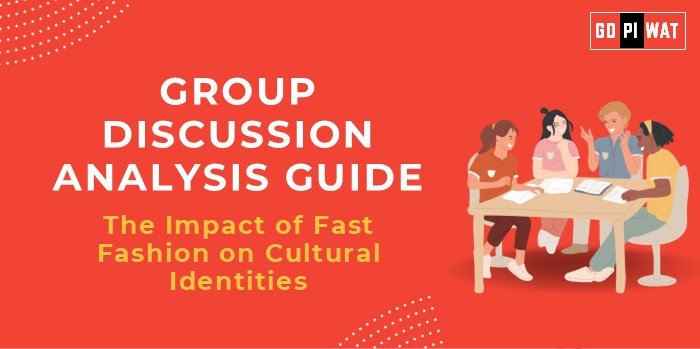📋 Group Discussion Analysis Guide: The Impact of Fast Fashion on Cultural Identities
🌐 Introduction to the Topic
Fast fashion has transformed global consumption patterns, allowing rapid access to trendy apparel at affordable prices. However, this trend comes at a cultural cost, as it often overlooks local traditions, crafts, and identities, favoring a homogenized global style over indigenous aesthetics. This topic is particularly relevant for B-school students as it intersects with consumer behavior, brand ethics, and cultural sustainability.
📊 Quick Facts and Key Statistics
- 🌍 Global Fast Fashion Market: Expected to reach $133 billion by 2026, underscoring rapid demand growth and global footprint.
- ♻️ Fashion Waste: 92 million tons annually, much of it comprising discarded fast fashion items, impacting both the environment and cultural heritage sites.
- 🎨 Loss of Traditional Crafts: Handloom and artisanal sectors have seen declines as mass-produced alternatives proliferate.
- 👗 Employment Concentration: Fast fashion production is heavily concentrated in developing countries, often sidelining local craftsmanship.
🧑🤝🧑 Stakeholders and Their Roles
- 👚 Fashion Brands: Influence trends and shape consumer expectations, but often emphasize profit over cultural preservation.
- 🛍️ Consumers: Drive demand for fast fashion but increasingly seek sustainable, culturally-sensitive options.
- 🎭 Local Artisans and Cultural Custodians: Preserve traditional techniques but face challenges competing with fast fashion prices.
- 🏛️ Governments and NGOs: Regulate and promote cultural preservation, yet their policies often struggle to counteract fast fashion’s influence.
✨ Achievements and Challenges
🌟 Achievements
- 🏅 Increased accessibility to trendy clothing for a global audience.
- 📈 Economic growth and job creation in garment manufacturing sectors of developing countries.
- 💡 Rising consumer awareness and interest in ethical fashion.
⚠️ Challenges
- 🌍 Cultural Homogenization: Traditional designs are often replicated without cultural significance, diluting unique identities.
- 🛠️ Unsustainable Production: Environmental and social concerns persist due to waste and unethical labor practices.
- 🎨 Competition for Artisans: Local artisans face declining demand as consumers favor cheaper, mass-produced goods.
🌎 Global Comparisons
- 🇯🇵 Japan: Balances traditional attire like kimonos with modern fashion, ensuring cultural identity preservation.
- 🇮🇹 Italy: Protects “Made in Italy” crafts through local manufacturing laws, promoting regional identity.
📖 Case Study
India’s Handloom Sector: Despite global interest, the sector has struggled due to the influx of cheap, fast-fashion imports. Government initiatives like “Make in India” seek to counteract this.
🗣️ Structured Arguments for Discussion
✅ Supporting Stance
“Fast fashion democratizes style, enabling individuals to access a variety of designs affordably, contributing to cultural exchange.”
❌ Opposing Stance
“Fast fashion erodes cultural identities, with traditional crafts replaced by homogenous designs, undermining local economies.”
⚖️ Balanced Perspective
“While fast fashion increases accessibility, it requires ethical considerations to prevent cultural dilution and environmental harm.”
🧭 Effective Discussion Approaches
🔑 Opening Approaches
- 🧵 Begin with the impact of fast fashion on a specific cultural symbol (e.g., traditional textiles).
- ♻️ Highlight the global waste crisis from discarded fashion.
- 🌍 Use a comparative approach, mentioning a region successfully balancing modern fashion with cultural preservation.
🎯 Counter-Argument Handling
- ⚖️ Acknowledge affordability but argue for balanced production with respect for cultural origins.
- 🤝 Present solutions like collaboration with local artisans or cultural labeling for authentic products.
📉 Strategic Analysis of Strengths and Weaknesses
- 💪 Strengths: Accessibility, economic growth in developing regions.
- ❌ Weaknesses: Cultural dilution, environmental impact.
- 🌱 Opportunities: Consumer interest in ethical fashion, support for local craftsmanship.
- ⚠️ Threats: Overconsumption, exploitative labor, declining artisanal industries.
🎓 Connecting with B-School Applications
🌍 Real-World Applications
Business strategy sessions on sustainable sourcing, or branding in culturally diverse markets.
📋 Sample Interview Questions
- 💼 “How can fast fashion companies balance profitability with cultural sensitivity?”
- 👗 “What role does consumer behavior play in the sustainability of fast fashion?”
💡 Insights for B-School Students
Understanding the ethical challenges of global business and exploring the potential for local-craft partnerships within multinational brands.


